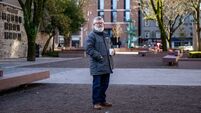Plenty to explore in natural heritage
A friend, who walks regularly at weekends all year round, come hail, rain or snow, is dead right when he says you have nothing to fear from the elements once you are appropriately clad and have proper footwear.
This is the International Year of Biodiversity – a term meaning all life on earth – and you don’t have to go too far in this country to experience biodiversity in all its glory. Simple things are beautiful by definition, reminding us of poet Patrick Kavanagh’s memorable line, ‘ordinary things wear lovely wings’.
It’s holiday time and people are taking to the outdoors in huge numbers. Rather than waiting for the sunshine, there’s no reason why Killarney National Park, Gougane Barra, or islands off the west Cork coast such as Cape Clear and Sherkin, cannot be explored in wet and windy weather. Such places can look even better between the showers.
Take the Old Kenmare Road that runs through Killarney National Park – a splendid walk that can last the best part of a day and takes in some of the most breathtaking lake, woodland and mountain scenery in Europe. Along the way, you’ll surely see Red deer, an attraction in their own right.
There are scores of much shorter walks, some of which were also mentioned in the 19th century guides for visitors to Killarney. One of the best known is the trek through the Gap of Dunloe, or (the lazy person’s option!) a walk from Derrycunnihy to Gearhameen, the pitstop for boats doing the classic Killarney trip through the three lakes, with the remainder on ponyback through the picturesque Gap of Dunloe.
A personal favourite among Lawrence photographs from the late 19th century is one of a group of relaxed picnickers, with the men in bowler hats and the women in ground-sweeping skirts, taken at Gerhameen. The scene is almost exactly the same today, but people wear jeans and tee-shirts.
Anyone heading for the west, and who has even a remote interest in the outdoors, has to savour the Burren where they can see at first hand an amazing range of flowering plants, all growing together in a truly unique landscape. Plants that can be traced to Arctic and Alpine areas thrive side-by-side with those found in Mediterranean areas.
Close to the Burren is Coole Park, in Co Galway. Best known as the home of Lady Gregory, and the inspiration for many of the poems of William Butler Yeats, this is a place where history, heritage and nature can be enjoyed all together.
Everyone has heard of the wild swans of Coole, but the swans have company in wigeon, mallard, teal, curlew and dunlin, whilst the gardens and woods are generously endowed with plant life.
Further north, Glenveagh National Park, in Co Donegal, is a rugged wilderness area where you might see a golden eagle or other birds of prey, including peregrine falcon, the mountain hare and golden plover.
People visiting Dublin tend to go for city attractions, especially on wet days, but Dublin’s North Bull Island, a bird sanctuary and nature reserve, is an attraction in all weathers. Here, upwards of 180 bird species and 300 plant species have been recorded, with plenty of wild fowl and waders.
Nearly 90 species of reptile are found in continental Europe, but only one, the common lizard, is native to Ireland. However, a second, the slow-worm, has recently been introduced to the Burren – a leg-less lizard that looks rather like a small snake.
There are 53 European amphibian species and only three in Ireland of which one, the common frog, was probably introduced by humans. The other two are the natterjack toad, which is rare and only found in a few areas of Co Kerry, including Dooks Golf Club, with the exception of a small population introduced to County Wexford for conservation reasons, and the smooth newt.
Sometimes species are confined to certain areas because they become isolated and are unable to travel and spread. Natterjack toads, for example, can only live in sand dunes which have ponds of fresh or slightly salty water in which to breed.
These ponds are called dune slacks and they can disappear as a result of winter storms or, sometimes, human development. If this happens, the toads have nowhere to breed and they’re too slow-moving to head off across country to look for another dune system. The local population then dies out.
Toads, which are nurtured in Dooks where habitat is provided for them, are an endangered species in Ireland. That is why, some years ago, the Government moved a small number of Kerry toads to a suitable sand dune system in Wexford Harbour.
* www.noticenature.ie.













